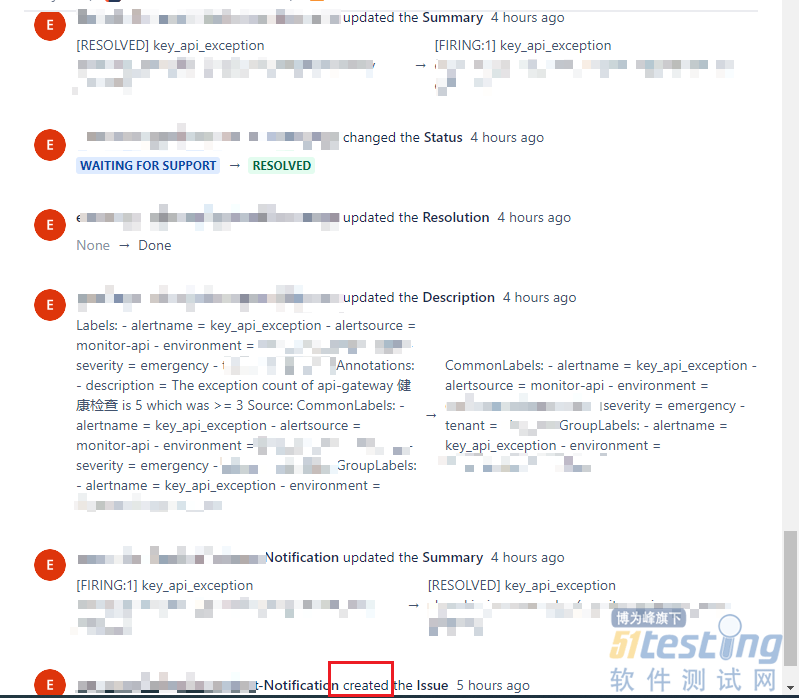简介
Alertmanager 处理由客户端应用程序(如 Prometheus server)发送的警报。它负责去重(deduplicating),分组(grouping),并将它们路由(routing)到正确的接收器(receiver)集成,如电子邮件,微信,或钉钉。它还负责处理警报的静默/屏蔽(silencing)、定时发送/不发送(Mute)和抑制(inhibition)问题。
AlertManager 作为 开源的为 Prometheus 而设计的告警应用, 已经具备了告警应用各类丰富、灵活、可定制的功能。
用于JIRA的Prometheus Alertmanager Webhook Receiver。
JIRAlert实现了Alertmanager的webhook HTTP API,并连接到一个或多个JIRA实例以创建高度可配置的JIRA Issues。每个不同的 Groupkey 创建一个Issue--由Alertmanager的路由配置部分的group_by参数定义--但在警报解决时不会关闭(默认参数, 可调整)。我们的期望是,人们会查看这个issue。,采取任何必要的行动,然后关闭它。如果没有人的互动是必要的,那么它可能首先就不应该报警。然而,这种行为可以通过设置auto_resolve部分进行修改,它将以所需的状态解决jira issue。
如果一个相应的JIRA issue。已经存在,但被解决了,它将被重新打开(reopened)。在解决的状态和重开的状态之间必须存在一个JIRA transition--如reopen_state--否则重开将失败。可以选择定义一个 "won't fix" 的决议(resolution)--由wont_fix_resolution定义:有此决议的JIRA问题将不会被JIRAlert重新打开。
安装 Jiralert
Jiralert 的安装比较简单, 主要由 Deployment、Secret(Jiralert 的配置)和 Service 组成。典型示例如下:
apiVersion: apps/v1
kind: Deployment
metadata:
name: jiralert
spec:
selector:
matchLabels:
app: jiralert
template:
metadata:
labels:
app: jiralert
spec:
containers:
- name: jiralert
image: quay.io/jiralert/jiralert-linux-amd64:latest
imagePullPolicy: IfNotPresent
args:
- "--config=/jiralert-config/jiralert.yml"
- "--log.level=debug"
- "--listen-address=:9097"
readinessProbe:
tcpSocket:
port: 9097
initialDelaySeconds: 15
periodSeconds: 15
timeoutSeconds: 5
livenessProbe:
tcpSocket:
port: 9097
initialDelaySeconds: 15
periodSeconds: 15
timeoutSeconds: 5
ports:
- containerPort: 9091
name: metrics
volumeMounts:
- mountPath: /jiralert-config
name: jiralert-config
readOnly: true
volumes:
- name: jiralert-config
secret:
secretName: jiralert-config
---
apiVersion: v1
kind: Secret
type: Opaque
metadata:
name: jiralert-config
stringData:
jiralert.tmpl: |-
{{ define "jira.summary" }}[{{ .Status | toUpper }}{{ if eq .Status "firing" }}:{{ .Alerts.Firing | len }}{{ end }}] {{ .GroupLabels.SortedPairs.Values | join "," }}{{ end }}
{{ define "jira.description" }}{{ range .Alerts.Firing }}Labels:
{{ range .Labels.SortedPairs }} - {{ .Name }} = {{ .Value }}
{{ end }}
Annotations:
{{ range .Annotations.SortedPairs }} - {{ .Name }} = {{ .Value }}
{{ end }}
Source: {{ .GeneratorURL }}
{{ end }}
CommonLabels:
{{ range .CommonLabels.SortedPairs }} - {{ .Name }} = {{ .Value}}
{{ end }}
GroupLabels:
{{ range .GroupLabels.SortedPairs }} - {{ .Name }} = {{ .Value}}
{{ end }}
{{ end }}
jiralert.yml: |-
# Global defaults, applied to all receivers where not explicitly overridden. Optional.
template: jiralert.tmpl
defaults:
# API access fields.
api_url: https://jira.example.com
user: foo
password: bar
# The type of JIRA issue to create. Required.
issue_type: Bug
# Issue priority. Optional.
priority: Major
# Go template invocation for generating the summary. Required.
summary: '{{ template "jira.summary" . }}'
# Go template invocation for generating the description. Optional.
description: '{{ template "jira.description" . }}'
# State to transition into when reopening a closed issue. Required.
reopen_state: "REOPENED"
# Do not reopen issues with this resolution. Optional.
wont_fix_resolution: "Won't Fix"
# Amount of time after being closed that an issue should be reopened, after which, a new issue is created.
# Optional (default: always reopen)
# reopen_duration: 30d
# Receiver definitions. At least one must be defined.
# Receiver names must match the Alertmanager receiver names. Required.
receivers:
- name: 'jiralert'
project: 'YOUR-JIRA-PROJECT'
---
apiVersion: v1
kind: Service
metadata:
name: jiralert
spec:
selector:
app: jiralert
ports:
- port: 9097
targetPort: 9097
相应 AlertManager 的配置:
...
receivers:
- name: jiralert
webhook_configs:
- send_resolved: true
url: http://jiralert:9097/alert
routes:
- receiver: jiralert
matchers:
- severity = critical
continue: true
...
说明:
官方 jiralert 镜像地址: https://quay.io/repository/jiralert/jiralert-linux-amd64?tab=tags
官方 jiralert latest 镜像: <quay.io/jiralert/jiralert-linux-amd64:latest>
jiralert.tmpl 类似 AlertManager 的 Template, 发送到 Jira 的 Issue 会以此为模板。
jiralert.yml Jiralert 的配置文件:
·defaults 基础版配置
· receivers 可以设置多个 receiver, 届时 AlertManager 要发到哪个 Jira 的receiver就需要与这个 jiralert 的receiver 同名. (比如上面的例子, 都是jiralert)
Jiralert 配置
经过生产实践的 Jiralert 完整配置如下:
# Global defaults, applied to all receivers where not explicitly overridden. Optional.
template: jiralert.tmpl
defaults:
# API access fields.
api_url: https://example.atlassian.net
user: <your-account-email>
password: '<your-account-api-token>'
# The type of JIRA issue to create. Required.
issue_type: Support
# Issue priority. Optional.
priority: High
# Go template invocation for generating the summary. Required.
summary: '{{ template "jira.summary" . }}'
# Go template invocation for generating the description. Optional.
description: '{{ template "jira.description" . }}'
# State to transition into when reopening a closed issue. Required.
reopen_state: "Back to in progress"
# Do not reopen issues with this resolution. Optional.
wont_fix_resolution: "Won't Do"
# Amount of time after being closed that an issue should be reopened, after which, a new issue is created.
# Optional (default: always reopen)
reopen_duration: 30d
# Receiver definitions. At least one must be defined.
# Receiver names must match the Alertmanager receiver names. Required.
receivers:
- name: 'jiralert'
project: <your-project-code>
add_group_labels: true
auto_resolve:
state: 'Resolve this issue'
详细说明如下:
1. api_url: Jira 的地址, 如果用的是 Jira 的 SaaS 服务, 就是https://<tenant>.atlassian.net
2. 认证:
·对于公有云版的 Jira, 只能用 user 和 password, 其中:
user 填写你的账号邮箱地址;
password 需要先在 API Token | Atlassian account 申请 API Token。(注意: 登录用的密码是无法认证通过的)
· 对于其他版本, 也可以填写使用 personal_access_token 进行认证. 其值为: user@example.com:api_token_string 的 base64 编码后字符串. 具体说明见: Basic auth for REST APIs (atlassian.com)
3. issue_type: 根据您的 Jira Issue Type 来填写, 可能是: Alert Support Bug New Feature 等等或其他。
4. priority 根据您的 Issue priority 来填写, 可能是: Critical High Medium Low 等等或其他。
5. reopen_state: Jira 的问题已经关闭, 要重新打开, 需要的 transition, 如: Back to in progress。(注意: 这里需要填写的是您自定义的 transition, 而非 status)
6. wont_fix_resolution: 带有这个 resolution (解决方案)的问题就不会重新打开. 如: Won't Do Won't Fix, 需要根据自己的 resolution 定义内容来填写。
7. reopen_duration: 多久时间之内的问题会重新打开, 默认是 always reopen, 可以设置为如: 30d, 表示这个问题如果30天以前有同样的问题, 新开一个 Issue, 而不是重新打开老的 Issue。
8. receivers: 可以定义多个 receivers, 指向不同 project。
9. project: Jira 的 Project ID, 是 Project 详细名字的首字母大写. 如 Project 是 For Example, 这里就填写 FE。
10. add_group_labels: 是否要将 AlertManager 的 Group Labels 加到 Jira 的 Labels。(注意: Jira Labels 的 Value 是不能有空格的, 所以如果你的 AlertManager 的 Group Label 的Value如果有空格, 不要开启此项功能)
10. auto_resolve: 最新 1.2 版本新增的功能, 当告警恢复了, 可以自动 resolve 对应的 Jira Issue。
11. state: 'Resolve this issue' 这里也是要填写您预定义的 Jira 解决该问题的 transition 而非 status, 如'Resolve this issue'。
其他疑难情况
如果你碰到各种诡异的日志, 原因大部分都是因为没有正确认证登录导致的, 典型的比如这个报错:
The value 'XXX' does not exist for the field 'project'.
事实上就是因为没有正确认证登录导致的。
还有一类报错, 提示您无法 transition an issue, 这往往是因为以下几种原因:
1、Jiralert 中reopen_state 或 auto_resolve 的 state 没有填写正确的 transition
2、您用的账号没有相应的权限
3、该 Issue 现在所处的状态(比如 Closed)不允许再进行 transition
最终效果
如下图:
可以创建 Issue, 更新 Summary, 更新 Description, 更新 Resolution, 更新 Status; 同样问题再次出现, reopen 之前的 Issue...
本文内容不用于商业目的,如涉及知识产权问题,请权利人联系51Testing小编(021-64471599-8017),我们将立即处理
















